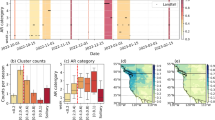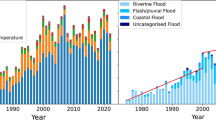Abstract
As changes to the environment, both human and non-human made, continue to occur, the assumption of stationarity in flood frequency analysis is seldom met. A proposed method for estimating the 1% chance flood, i.e., Q\(_{100}\) of a flood gauge’s annual peak streamflows, using robust local likelihood estimation is developed. Simulations indicate that when a flood series seems to be from a more mixed population of values, often due to extreme snowmelt or tropical storms in a given flood year, robust local likelihood estimation is more effective at estimating the 1% chance flood than local likelihood estimation. Annual peak streamflows from the Congaree River at Columbia, South Carolina, the Illinois River at Marseilles, Illinois, and the Winooski River at Montpelier, Vermont are used as examples on how to apply the robust local likelihood method.





Similar content being viewed by others
References
Alila Y, Mtiraoui A (2002) Implications of heterogeneous flood-frequency distributions on traditional stream-discharge prediction techniques. Hydrol Process 16:1065–1084
Box GEP, Meyer RD (1986) An analysis for unreplicated fractional factorials. Technometrics 28:11–18
Chavez-Demoulin V, Davison AC (2005) Generalized additive modelling of sample extremes. J R Stat Soc Ser C (Appl Stat) 54:207–222
Cleveland WS (1979) Robust locally weighted regression and smoothing scatterplots. J Am Stat Assoc 74(368):829–836. https://www.tandfonline.com/doi/abs/10.1080/01621459.1979.10481038
Cox DR, Isham VS, Northrop PJ (2002) Floods: Some probabilistic and statistical approaches. Philos Trans Math Phys Eng Sci 360(1796):1389–1408
Cunderlik JM, Burn DH (2003) Non-stationary pooled flood frequency analysis. J Hydrol 276:210–223
Cunnane C (1985) Factors affecting choice of distributions for flood series. Hydrol Sci J 30(1):25–36
Davison AC, Ramesh NI (2000) Local likelihood smoothing of sample extremes. J R Stat Soc Ser B (Stat Methodol) 62:191–208
Davison AC, Smith RL (1990) Models for exceedances over high thresholds. J R Stat Soc Ser B (Methodol ) 52(3):393–425
Diehl T, Potter KW (1987) Mixed flood distribution in Wisconsin. In: Singh VP (ed) Hydrologic frequency modeling. D. Reidel Publishing Company, Boston, Massachusetts, pp 213–226
El Adlouni S, Ouarda TBMJ, Zhang X, Roy R, Bobée B (2007) Generalized maximum likelihood estimators for the nonstationary generalized extreme value model. Water Resour Res 43:W03410. https://doi.org/10.1029/2005WR004545
Grego JM, Yates PA (2010) Point and standard error estimation for quantiles of mixed flood distributions. J Hydrol 391:289–301
Grego JM, Yates PA, Mai K (2015) Standard error estimation for mixed flood distributions with historic maxima. Environmetrics 26(3):229–242
Hall P, Tajvidi N (2000) Nonparametric analysis of temporal trend when fitting parametric model to extreme-value data. Stat Sci 15(2):153–167
Hirschboeck KK (1987) Hydrologically-defined mixed distributions in partial duration flood series. In: Singh VP (ed) Hydrologic frequency modeling. D. Reidel Publishing Company, Boston, Massachusetts, pp 199–212
Jóhannesson ÁV, Siegert S, Huser R, Bakka H, Hrafnkelsson B (2022) Approximate Bayesian inference for analysis of spatiotemporal flood frequency data. Ann Appl Stat 16(2):905–935
Katz RW, Parlange MB, Naveau P (2002) Statistics of extremes in hydrology. Adv Water Resour 25:1287–1304
Khaliq MN, Ouarda TBMJ, Ondo J-C, Gachon P, Bobée B (2006) Frequency analysis of a sequence of dependent and/or non-stationary hydro-meteorological observations: a review. J Hydrol 329:534–552
Koutsoyiannis D, Montanari A (2015) Negligent killing of scientific concepts: the stationarity case. Hydrol Sci J 60(7–8):1174–1183
Leclerc M, Ouarda TBMJ (2007) Non-stationary regional flood frequency analysis at ungauged sites. J Hydrol 343:254–265
López J, Francés F (2013) Non-stationary flood frequency analysis in continental Spanish rivers, using climate and reservoir indices as external covariates. Hydro Earth Syst Sci 17:3189–3203
Machado MJ, Botero BA, López J, Francés F, Díez-Herrero A, Benito G (2015) Flood frequency analysis of historical flood data under stationary and non-stationary modelling. Hydrol Earth Syst Sci 19:2561–2576
Meilijson I (1989) A fast improvement to the EM algorithm on its own terms. J R Stat Soc Ser B (Methodol) 51(1):127–138
Milly PCD, Betancourt J, Falkenmark M, Hirsch RM, Kundzewicz ZW, Lettenmaier DP, Stouffer RJ (2008) Stationarity is dead: Whither water management? Science 319(1):573–574
Nasri B, El Adlouni S, Ouarda TBMJ (2013) Bayesian estimation for GEV-B-spline model. Open J Stat 3:118–128
Qu C, Li J, Yan L, Yan P, Cheng F, Lu D (2020) Non-stationary flood frequency analysis using cubic B-spline-based GAMLSS model. Water 12:1867
Ramesh NI, Davison AC (2002) Local models for exploratory analysis of hydrological extremes. J Hydrol 256:106–119
Renard B, Lang M, Bois P (2006) Statistical analysis of extreme events in a nonstationary context via a Bayesian framework. Case study with peak-over-threshold data. Stochast Environ Res Risk Assess 21(2):97–112
Rigby RA, Stasinopoulos DM (2005) Generalized additive models for location, scale and shape. J R Stat Soc Ser C (Appl Stat) 54:507–554
Sankarasubramanian A, Lall U (2003) Flood quantiles in a changing climate: seasonal forecasts and causal relations. Water Resour Res 39(5):1134
Serinaldi F, Kilsby CG (2015) Stationarity is undead: uncertainty dominates the distribution of extremes. Adv Water Resour 77:17–36
Singh KP (1968) Hydrologic distributions resulting from mixed population and their computer simulation In: Proceedings of the international symposium of the use of analog and digital computers in hydrology. International Association of Scientific Hydrology, pp 671–681
Singh KP (1987) A versatile flood frequency methodology. Water Int 12(3):139–145
Singh KP, Sinclair RA (1972) Two-distribution method for flood frequency analysis. Water Resour Res 7(5):1144–1150
Slater LJ, Anderson B, Buechel M, Dadson S, Han S, Harrigan S, Kelder T, Kowal K, Lees T, Matthews T, Murphy C, Wilby RL (2021) Nonstationary weather and water extremes: a review of methods for their detection, attribution, and management. Hydrol Earth Syst Sci 25(7):3897–3935
Strupczewski WG, Kaczmarek Z (2001) Non-stationary approach to at-site flood frequency modeling II. Weighted least squares estimation. J Hydrol, pp 143–151
Strupczewski WG, Singh VP, Feluch W (2001) Non-stationary approach to at-site flood frequency modeling I. Maximum likelihood estimation. J Hydrol 248:123–142
Strupczewski WG, Singh VP, Mitosek HT (2001) Non-stationary approach to at-site flood frequency modeling III. Flood analysis of Polish rivers. J Hydrol 248:152–167
Tarasova L, Merz R, Kiss A, Basso S, Blöschl G, Merz B, Viglione A, Plötner S, Guse B, Schumann A, Fischer S, Ahrens B, Anwar F, Bárdossy A, Bühler P, Haberlandt U, Kreibich H, Krug A, Lun D, Müller-Thomy H, Pidoto R, Primo C, Seidel J, Vorogushyn S, Wietzke L (2019) Causative classification of river flood events. WIREs Water 6(4):e1353
Villarini G, Smith JA, Serinaldi F, Bales J, Bates PD, Krajewski WF (2009) Flood frequency analysis for nonstationary annual peak records in an urban drainage basin. Adv Water Resour 32:1255–1266
Vogel RM, Yaindl C, Walter M (2011) Nonstationarity: flood magnification and recurrence reduction factors in the United States. J Am Water Resour Assoc 47(3):464–474
Waylen P, Woo MK (1982) Prediction of annual floods generated by mixed processes. Water Resour Res 18(4):1283–1286
Waylen P, Woo MK (1983) Annual floods in South Western British Columbia, Canada. J Hydrol 62:95–105
Funding
The authors of this paper received no funding nor had any conflict of interest while developing the work for this paper.
Author information
Authors and Affiliations
Corresponding author
Additional information
Publisher's Note
Springer Nature remains neutral with regard to jurisdictional claims in published maps and institutional affiliations.
Appendix
Appendix
We need to derive and evaluate the Jacobian at \(\left\{ t_i\right\} \) in order to construct a sandwich estimator for the covariance matrices of their respective maximum likelihood estimates. The density function \(f(\cdot ;\cdot )\) for each component can be written as:
where
The log of the density can be written as:
The key in the following calculations is \(k_{1}\); of particular utility are the following results:
Using the results derived for \(k_1\) above, the components of the score vector are given below.
These formulas, evaluated at \(\left\{ t_i\right\} \), can be used to construct the score \(\frac{\partial }{\partial {\varvec{\Theta }}_{i}}\log l({\varvec{\Theta }}_{i}) = {\varvec{s}}_i\) for each observation i; the total score can be computed as \({\varvec{S}}\left( {\varvec{\Theta }}\right) = \sum _{i=1}^n {\varvec{s}}_i \).
The components summed to comprise the elements of J(t) for \(f_{1}\left( y_{i}|{\varvec{\Theta }}_{t}\right) \), the observed information matrix for the local linear model, can be written as:
where
Rights and permissions
Springer Nature or its licensor (e.g. a society or other partner) holds exclusive rights to this article under a publishing agreement with the author(s) or other rightsholder(s); author self-archiving of the accepted manuscript version of this article is solely governed by the terms of such publishing agreement and applicable law.
About this article
Cite this article
Grego, J.M., Yates, P.A. Robust Local Likelihood Estimation for Non-stationary Flood Frequency Analysis. JABES (2024). https://doi.org/10.1007/s13253-024-00614-0
Received:
Revised:
Accepted:
Published:
DOI: https://doi.org/10.1007/s13253-024-00614-0




